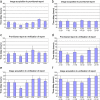Radiographic imaging for traumatic ankle injuries: a demand profile and investigation of radiological reporting timeframes from an Australian tertiary facility
- PMID: 24883110
- PMCID: PMC4039056
- DOI: 10.1186/1757-1146-7-25
Radiographic imaging for traumatic ankle injuries: a demand profile and investigation of radiological reporting timeframes from an Australian tertiary facility
Abstract
Background: Radiographic examinations of the ankle are important in the clinical management of ankle injuries in hospital emergency departments. National (Australian) Emergency Access Targets (NEAT) stipulate that 90 percent of presentations should leave the emergency department within 4 hours. For a radiological report to have clinical usefulness and relevance to clinical teams treating patients with ankle injuries in emergency departments, the report would need to be prepared and available to the clinical team within the NEAT 4 hour timeframe; before the patient has left the emergency department. However, little is known about the demand profile of ankle injuries requiring radiographic examination or time until radiological reports are available for this clinical group in Australian public hospital emergency settings.
Methods: This study utilised a prospective cohort of consecutive cases of ankle examinations from patients (n = 437) with suspected traumatic ankle injuries presenting to the emergency department of a tertiary hospital facility. Time stamps from the hospital Picture Archiving and Communication System were used to record the timing of three processing milestones for each patient's radiographic examination; the time of image acquisition, time of a provisional radiological report being made available for viewing by referring clinical teams, and time of final verification of radiological report.
Results: Radiological reports and all three time stamps were available for 431 (98.6%) cases and were included in analysis. The total time between image acquisition and final radiological report verification exceeded 4 hours for 404 (92.5%) cases. The peak demand for radiographic examination of ankles was on weekend days, and in the afternoon and evening. The majority of examinations were provisionally reported and verified during weekday daytime shift hours.
Conclusions: Provisional or final radiological reports were frequently not available within 4 hours of image acquisition among this sample. Effective and cost-efficient strategies to improve the support provided to referring clinical teams from medical imaging departments may enhance emergency care interventions for people presenting to emergency departments with ankle injuries; particularly those with imaging findings that may be challenging for junior clinical staff to interpret without a definitive radiological report.
Keywords: Ankle; Demand; Emergency; Fracture; Orthopaedic; Radiograph; Radiology; Reporting; Trauma; X-ray.
Figures


References
-
- Sarrafian SK. Anatomy of the Foot and Ankle: Descriptive, Topographic, Functional. 2. Philadelphia: JB Lippincott Company; 1993. pp. 16–190.
-
- Donatelli RA. In: The Biomechanics of the Foot and Ankle. Chapter 1. Davies FA, editor. Philadelphia: F. A. Davis Company; 1990. Normal Anatomy and Biomechanics.
-
- Lesic A, Bumbasirevic M. Ankle fractures. Curr Orthop. 2004;18:232–244. doi: 10.1016/j.cuor.2004.03.001. - DOI
LinkOut - more resources
Full Text Sources
Other Literature Sources

